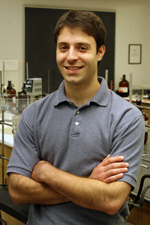

Main navigation | Main content

Professor Aaron Massari has received the 2014 George W. Taylor/College of Science & Engineering Alumni Award for Distinguished Teaching. Established in 1982, this award recognizes outstanding contributions to undergraduate and/or graduate teaching.
Since joining the faculty in the Department of Chemistry in 2006, Massari has established a reputation for innovative and enthusiastic teaching. He has taught more than 1,600 undergraduate students and more than 110 graduate students, served as a mentor to aspiring teachers, and contributed to educational literature.
He has received outstanding evaluations from the spectrum of learners, ranging from entry-level students in general chemistry, through advanced undergraduate majors in the physical chemistry laboratory course, to graduate students in quantum mechanics, materials characterization, and laser spectroscopy courses. He has developed new courses, significantly revamped the curriculum in existing courses, and increased enrollment in difficult courses.
When he began in the Chemistry Department, Massari renovated the advanced physical chemistry laboratory course. He reorganized many of the older lab experiments and implemented modifications and online assignments that gave those exercises a modern and relevant flair. He replaced decades old instruments with newer, more sophisticated versions, and made modern computational software a regular complement to many of the studies. In addition to explaining the requisite laboratory procedures, his lectures connected the lab work with real world applications. Demand for this course increased dramatically and three sections are now offered. Positive student evaluations followed, including, "[Chem 4511] was a challenging course, and required a lot of work, but I learned a lot and have a liking toward physical chemistry that I didn't have before."
Massari has also excelled at teaching freshmen and sophomores from a broad range of majors in the general chemistry curriculum. His enthusiasm for teaching chemistry was most evident in his almost-daily demonstrations in Chemistry 1022, often leading to dramatic, loud, and flashy results. Some of the most notable demonstrations were effective at breaking down barriers between the instructor and the large audience. In one example, the class provided "thermal energy" to beach ball "reactants" with velcro "binding sites" to try to get them to form a "bond." Students at the edge of the lecture hall stood up to contain the reaction in a lecture hall-sized "beaker." At the end of this aerobic activity, it became clear that, despite multiple collisions of the reactants, the beach balls were only rarely able to form a velcro bond since they needed to collide with a very specific orientation and speed. This is the foundational view of collision theory, a topic that is normally covered in an abstract mathematical way. In another case, balloons were placed in the classroom at the beginning of the lecture, and then at a later time their locations were pointed out. The students inadvertently participated in the demonstration by moving the balloons around. By noting that the balloons near the walls moved a shorter distance than the ones that originated in the middle of the room, Massari was able to illuminate one of the defining aspects of entropy, a very complex topic for an introductory course.
It can be challenging to remain connected to students in large lecture courses like Chemistry 1022, but Massari always found ways to connect with his audience, including implementing cell phone texting during class as a way of drawing out more participation from less vocal students; preparing podcasts through iTunesU for students to upload to mobile devices; and creating a webpage that drills students with practice problems before exams.
Massari has taught an impressive breadth of material that includes graduate-level Materials Characterization, Quantum Mechanics, and Laser Spectroscopy courses. He has organized workshops on lasers and optics, explaining the nuts and bolts of these instruments to graduate students, faculty, and staff. He also serves as a mentor to graduate students who aspire to teach, giving them opportunities to hone their own skills and sharing his experiences to improve their teaching abilities.
Massari's teaching abilities have also caught the attention of others. He was invited to join the highly successful Energy and U outreach program, a troupe of chemistry and chemical engineering faculty who draw 10,000 grade school kids to the campus for an hour-long show of lasers, explosions, and dancing. He also was invited by the University of Minnesota Southwest Regional Outreach Center to direct the chemistry track of its University on the Prairie program. This event engages 60 middle-school aged kids from rural parts of the state in three intensive days of hands-on activities, typically over topics that drive home the message that science plays important roles in agricultural communities, and to spark their interest in attending the University to study science.
Massari received his bachelor's degree from Arizona State University, and earned his doctorate at Northwestern University. After working as a National Institutes of Health post-doctoral fellow at Stanford University, he joined the Department of Chemistry faculty in 2006. He was promoted to associate professor in July 2013. His honors and awards include an Initiative for Renewable Energy & the Environment Early Investigator Award, a National Science Foundation CAREER Award, and a 3M Non-Tenured Faculty Award.
The George W. Taylor Awards are endowed within the College of Science and Engineering in memory of George W. Taylor, a 1934 graduate of the department of Mechanical Engineering. Nine professors in the Department of Chemistry have received this award, including current professors Mark Distefano, Marc Hillmyer, Doreen Leopold, Kenneth Leopold, and Kent Mann.